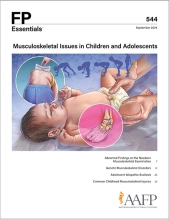
This clinical content conforms to AAFP criteria for CME.
Active children and adolescents have unique risk factors for musculoskeletal injuries compared with adults. Physes and developing bones are at higher risk of injury than tendons and ligaments. Children’s bone remodeling is robust, allowing most clavicle fractures and torus fractures of the forearm to be managed conservatively. Radial head subluxation is managed with reduction. Apophyseal injuries are traction or overuse injuries that typically can be managed nonoperatively. Osteochondritis dissecans and other osteochondroses require frequent monitoring and occasionally surgical intervention.
Case 4. AJ is a 14-year-old patient who is brought to your office by her parents for pain and swelling in the right ankle 2 days after an inversion injury during a basketball game. After the injury, AJ stopped playing, was unable to bear weight, and hopped to the bench on her left foot with assistance from her teammates. She has been icing and elevating the ankle with some improvement, but she is afraid to walk on it.
Ankle Injuries
Ankle injuries in patients younger than 18 years are common. The incidence in males peaks between ages 15 and 19 years, whereas incidence in females peaks between ages 10 and 14 years.120 Males fracture their ankles 2 times as frequently as females.121 In children and adolescents, the presence of a physis contributes to unique fracture patterns that the family physician must be aware of to properly manage the injury.
Subscribe
From $350- Immediate, unlimited access to FP Essentials content
- 60 CME credits/year
- AAFP app access
- Print delivery available
Edition Access
$44- Immediate, unlimited access to this edition's content
- 5 CME credits
- AAFP app access
- Print delivery available
